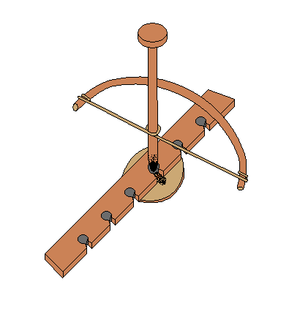m (4 revisions: re-import from WB, including edit history) |
|||
| Line 1: | Line 1: | ||
[[Image:Bow Drill.png|thumb|300px]] | [[Image:Bow Drill.png|thumb|300px]] | ||
| − | The "bow and drill" method is well-known and it is a lot of work. The bow is similar to that used for archery. To make such a bow, find a thin rope or flexible but sturdy | + | The "bow and drill" method is well-known and it is a lot of work. The bow is similar to that used for archery. To make such a bow, find a thin rope or flexible but sturdy bit of cordage, and a sturdy stick {{units|60-120 cm|2 to 4 feet}} long. Tie the rope to one end of the stick, and make another knot on the other end of the stick, with the rope between the ends not quite taut. |
The drill (or spindle) is another straight stick, thin but strong, preferably stripped of bark, sharpened on the bottom end and rounded on the top. The center of the bowstring (rope) is wrapped around the drill, with the bow and spindle at right angles to each other. The end of the spindle is placed on a fireboard. | The drill (or spindle) is another straight stick, thin but strong, preferably stripped of bark, sharpened on the bottom end and rounded on the top. The center of the bowstring (rope) is wrapped around the drill, with the bow and spindle at right angles to each other. The end of the spindle is placed on a fireboard. | ||
Revision as of 01:23, 9 November 2012
The "bow and drill" method is well-known and it is a lot of work. The bow is similar to that used for archery. To make such a bow, find a thin rope or flexible but sturdy bit of cordage, and a sturdy stick 60-120 cm![]() long. Tie the rope to one end of the stick, and make another knot on the other end of the stick, with the rope between the ends not quite taut.
long. Tie the rope to one end of the stick, and make another knot on the other end of the stick, with the rope between the ends not quite taut.
The drill (or spindle) is another straight stick, thin but strong, preferably stripped of bark, sharpened on the bottom end and rounded on the top. The center of the bowstring (rope) is wrapped around the drill, with the bow and spindle at right angles to each other. The end of the spindle is placed on a fireboard.
The fireboard is a piece of dry, softwood (cedar is excellent), with a conical impression in the top surface (such as might be made with a countersink). This impression is bored near the edge of the fireboard, and a notch is cut into it. The apex of the notch should be at the center of the impression. Place a card or a piece of bark beneath the notch to catch the hot wood which the spindle will grind off the fireboard.
The top of the spindle is rounded and smoothed, and placed in a socket made of a hardwood, bone, stone, or something similar. The socket should be smoothed and greased to reduce friction - you do not want to generate heat in the socket.
Once the equipment is ready, gather some tinder. This tinder should be easily lit. Dry grass, pine needles, and dryer lint all work well for this. Form the tinder pile into the shape of a bird's nest. Then make sure you have enough kindling on hand and an easily lit fire laid with fuel ready to go. When tinder bursts into flames, it is not the right time to start looking for kindling and fuel. Do this ahead of time.
Once the spindle is in place with its bottom tip in the impression in the fireboard, the top held firmly by the socket, and the cord wrapped around its center, the fire builder will move the bow back and forth quickly to rotate the spindle. Long strokes are better than short strokes.
If the socket is pressed too hard, the spindle will not spin. If it is not pressed hard enough, the spindle will come loose.
After only a few seconds of spinning the spindle, the fireboard should begin to smoke. Keep working the bow. After about a minute of smoke, look for a pile of hot wood powder to accumulate in the notch, caught on the card or bark placed beneath it. Stop working the bow and see if the wood powder continues to smoke. If it does not, work the bow again.
When the wood powder continues to smoke after the spindle stops, carefully pick up the card or bark, slide the wood powder into the center of the bird's nest tinder pile, and gently blow on the wood powder. Slowly increase the strength of the air stream blown into the tinder. It should glow red, and as more air is forced into it and the tinder worked into the ember, it should glow even brighter. Eventually when you take your next breath, the tinder pile will burst into flames. Place the burning tinder beneath the kindling and tend the fire as you would any newly lit fire.

